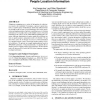ECIS
2000
14 years 4 months ago
2000
The concept of context-dependent access control has emerged during the last years: Information about the state of a process model of a working environment is combined with general ...
WSC
2001
14 years 4 months ago
2001
The United States Department of Defense (DoD) has, over the past several years, emphasized the need to employ simulation based acquisition (SBA) in engineering and development. Di...
CCS
2008
ACM
14 years 5 months ago
2008
ACM
Pervasive computing environments have created a requirement for spatial- and temporal-aware access control systems. Although temporal, spatial and spatio-temporal role-based acces...
ACSAC
2002
IEEE
14 years 8 months ago
2002
IEEE
The Role-Based Access Control (RBAC) model is traditionally used to manually assign users to appropriate roles, based on a specific enterprise policy, thereby authorizing them to ...
SACMAT
2003
ACM
14 years 8 months ago
2003
ACM
Role-based Access Control (RBAC) models have been implemented not only in self-contained resource management products such as DBMSs and Operating Systems but also in a class of pr...
SDMW
2004
Springer
14 years 8 months ago
2004
Springer
Abstract. Due to the growing interest in XML security, various access control schemes have been proposed recently. However, little effort has been put forth to facilitate a unifor...
SACMAT
2004
ACM
14 years 8 months ago
2004
ACM
Ubiquitous computing uses a variety of information for which access needs to be controlled. For instance, a person’s current location is a sensitive piece of information, which ...
SACMAT
2006
ACM
14 years 9 months ago
2006
ACM
We introduce the concept, model, and policy-specific algorithms for inferring new access control decisions from previous ones. Our secondary and approximate authorization model (...
IPPS
2006
IEEE
14 years 9 months ago
2006
IEEE
Having reliable security in systems is of the utmost importance. However, the existing framework of writing, distributing and linking against code in the form of libraries and/or ...
SACMAT
2009
ACM
14 years 9 months ago
2009
ACM
An access control system is often viewed as a state transition system. Given a set of access control policies, a general safety requirement in such a system is to determine whethe...




